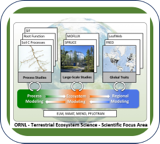Uncertainty in gridded CO2 emissions estimates
| Author | |
|---|---|
| Keywords | |
| Abstract |
We are interested in the spatial distribution of fossil-fuel-related emissions of CO2 for both geochemical and geopolitical reasons, but it is important to understand the uncertainty that exists in spatially explicit emissions estimates. Working from one of the widely used gridded data sets of CO2 emissions, we examine the elements of uncertainty, focusing on gridded data for the United States at the scale of 1º latitude by 1º longitude. Uncertainty is introduced in the magnitude of total United States emissions, the magnitude and location of large point sources, the magnitude and distribution of non-point sources, and from the use of proxy data to characterize emissions. For the United States, we develop estimates of the contribution of each component of uncertainty. At 1º resolution, in most grid cells, the largest contribution to uncertainty comes from how well the distribution of the proxy (in this case population density) represents the distribution of emissions. In other grid cells, the magnitude and location of large point sources make the major contribution to uncertainty. Uncertainty in population density can be important where a large gradient in population density occurs near a grid cell boundary. Uncertainty is strongly scale-dependent with uncertainty increasing as grid size decreases. Uncertainty for our data set with 1º grid cells for the United States is typically on the order of ±150%, but this is perhaps not excessive in a data set where emissions per grid cell vary over 8 orders of magnitude.
|
| Year of Publication |
2016
|
| Journal |
Earth's Future
|
| Volume |
4
|
| Number of Pages |
225-239
|
| ISSN Number |
2328-4277
|
| URL |
http://dx.doi.org/10.1002/2015EF000343
|
| DOI |
10.1002/2015EF000343
|
| Download citation |

